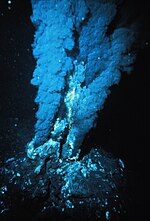Hydrogen isotope biogeochemistry is the scientific study of biological, geological, and chemical processes in the environment using the distribution and... 244 KB (30,904 words) - 22:20, 12 April 2024 |
isotope biogeochemistry is the study of the distribution of sulfur isotopes in biological and geological materials. In addition to its common isotope... 76 KB (8,512 words) - 15:11, 6 January 2024 |
 | Hydrogen sulfide is a chemical compound with the formula H2S. It is a colorless chalcogen-hydride gas, and is poisonous, corrosive, and flammable, with... 75 KB (7,929 words) - 11:24, 6 May 2024 |
on the isotope in question, the hydrogen cation has different names: Hydron: general name referring to the positive ion of any hydrogen isotope (H+) Proton:... 11 KB (1,500 words) - 09:09, 18 September 2023 |
 | Phosphate (redirect from Hydrogen Phosphate) the various phosphates because of their key roles in biochemistry, biogeochemistry, and ecology, and their economic importance for agriculture and industry... 29 KB (2,574 words) - 20:47, 2 May 2024 |
signature Radiometric dating Isotope-ratio mass spectrometry Sulfur isotope biogeochemistry Urey–Bigeleisen–Mayer equation Drever, James (2002). The Geochemistry... 21 KB (2,408 words) - 19:03, 1 April 2024 |
Nitrogen-15 tracing is an important method used in biogeochemistry. The ratio of stable nitrogen isotopes, 15N/14N or δ15N, tends to increase with trophic... 41 KB (4,662 words) - 23:38, 26 April 2024 |
 | Marine biogeochemical cycles (redirect from Ocean biogeochemistry) land. There are biogeochemical cycles for the elements calcium, carbon, hydrogen, mercury, nitrogen, oxygen, phosphorus, selenium, and sulfur; molecular... 119 KB (10,775 words) - 12:32, 3 May 2024 |
especially those ones in the vicinity of island of stability. Sulfur isotope biogeochemistry "Standard Atomic Weights: Sulfur". CIAAW. 2009. Prohaska, Thomas;... 10 KB (718 words) - 22:47, 3 December 2023 |
 | lava Stratospheric sulfur aerosols Sulfur assimilation Sulfur isotope biogeochemistry Ultra-low sulfur diesel "Standard Atomic Weights: Sulfur". CIAAW... 98 KB (10,951 words) - 01:31, 5 May 2024 |
Methane clumped isotopes are methane molecules that contain two or more rare isotopes. Methane (CH4) contains two elements, carbon and hydrogen, each of which... 35 KB (3,939 words) - 01:38, 4 March 2024 |
 | Acetylene (section Hydrogenation) discovered in 1836 by Edmund Davy, who identified it as a "new carburet of hydrogen". It was an accidental discovery while attempting to isolate potassium... 44 KB (4,324 words) - 03:02, 7 April 2024 |
concerned with the biochemistry of the Early Earth with a focus on isotope-biogeochemistry and the evidence of the earliest life processes in Precambrian... 57 KB (7,063 words) - 06:41, 26 November 2023 |
Trace metal stable isotope biogeochemistry is the study of the distribution and relative abundances of trace metal isotopes in order to better understand... 110 KB (13,523 words) - 21:49, 1 February 2024 |
 | 3d9 4s1. The isotopes of nickel range in atomic weight from 48 u (48 Ni) to 82 u (82 Ni). Natural nickel is composed of five stable isotopes, 58 Ni, 60... 90 KB (9,845 words) - 10:10, 24 April 2024 |
 | Hydrothermal vent (section Ocean biogeochemistry) elements to the world's oceans, thus contributing to global marine biogeochemistry. Relative to the majority of the deep sea, the areas around hydrothermal... 115 KB (13,399 words) - 19:15, 1 May 2024 |
Urey–Bigeleisen–Mayer equation (category Biogeochemistry) processes. Timeline of the Manhattan Project Isotope-ratio mass spectrometry Hydrogen isotope biogeochemistry Bigeleisen & Mayer (1947) contains the addendum:... 25 KB (2,376 words) - 12:11, 26 February 2024 |
 | Rock hyrax midden (category Biogeochemistry) proxies, including fossil pollen and stable carbon, nitrogen and hydrogen isotopes. Combined with the antiquity of hyrax middens, and the often-continuous... 59 KB (7,376 words) - 20:11, 9 February 2024 |
 | of long-lived radioactive isotopes. Bismuth was long thought to be non-radioactive, but 209 Bi (its longest lived isotope) actually decays with a half... 78 KB (8,830 words) - 18:21, 27 April 2024 |
 | Molybdenum (section Isotopes) 100. Of these naturally occurring isotopes, only molybdenum-100 is unstable. Molybdenum-98 is the most abundant isotope, comprising 24.14% of all molybdenum... 71 KB (8,065 words) - 18:12, 27 April 2024 |










